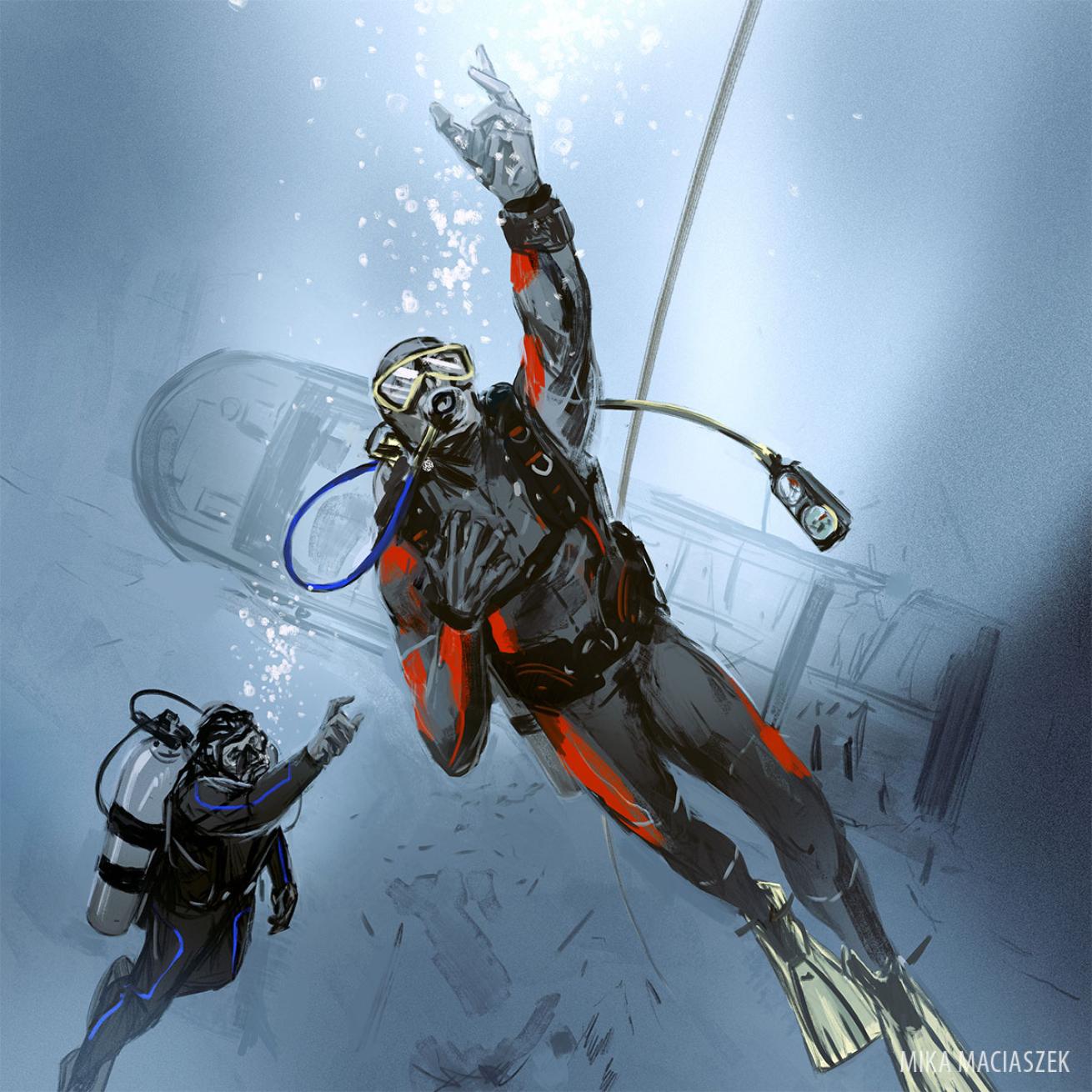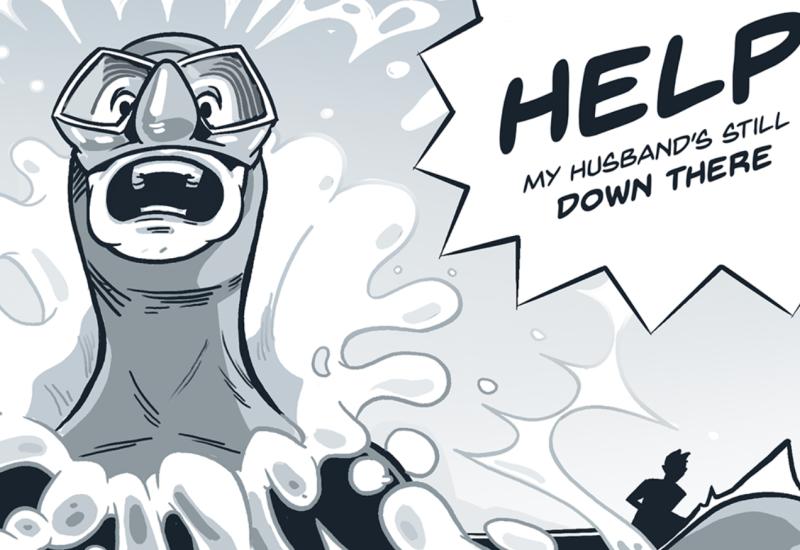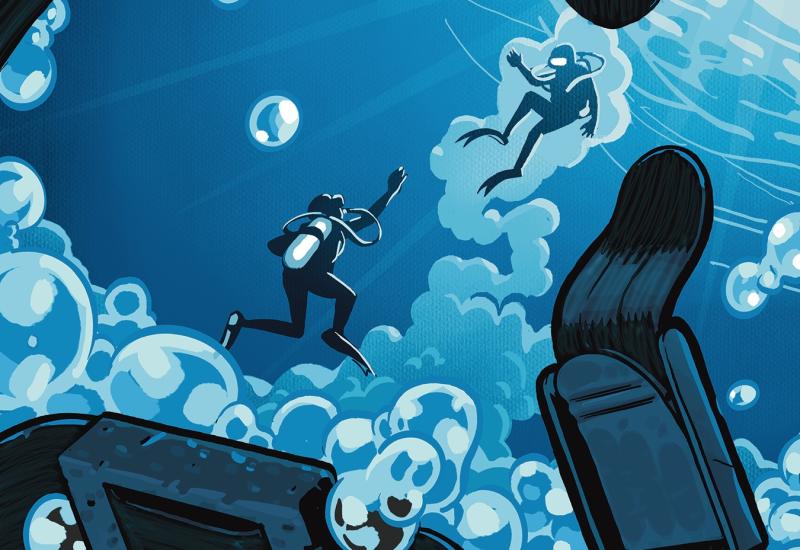An Inexperienced Diver Gets in Too Deep
It was gloomy and dark when Steve and his buddy reached the barge sitting on the lake’s bottom, but Steve was excited for the dive despite the conditions. He was setting a personal depth record and couldn’t wait to tell his new friends back at the shop. He and Alan swam around the barge at its deepest point and did their best to act interested. There really wasn’t all that much to see, but it didn’t matter. Diving the barge was a personal goal for Steve and Alan, and they were finally getting to do it.
When Steve noticed it was getting hard to breathe, he looked at his air pressure gauge. That was when he realized he was in trouble.

Miko MaciaszekWith both Steve and Alan breathing from a single air source, they didn’t make it very far before Alan’s tank was empty as well.
THE DIVER
Steve was new to diving. He had been certified just a year earlier, but according to his wife, it had taken over his life. He made a couple of trips to the ocean with his local dive shop, but he was at the lake diving every chance he could. He came home every time talking about how much fun he had just floating and feeling like an astronaut. He was in good health with no major problems, and he wasn’t taking any medications.
THE DIVE
While they had made dozens of dives in the lake, this was the first time Steve and Alan had dived on the barge. It was a deep dive; the barge was resting on the bottom in 112 feet of fresh water. The two divers had been practicing and working up to making a dive at that depth.
The fraternity of divers hanging around the dive shop talking about the barge made it almost sound like a rite of passage. Steve and Alan were good divers, and they were eager to prove it by getting to the barge, just like the other guys at the shop.
It was a typical early-fall day, with air temperatures in the mid-60s, when they began the dive. The water temperature was about the same on the surface but dropped to the low 50s by the time they reached the bottom. As they descended, the two men followed a chain connected to a surface marker.
When they reached the barge, Steve and Alan circled it, and then Alan took photos of Steve hovering inside an open hatch. They couldn’t wait to show the photos to their friends at the dive shop.
THE ACCIDENT
Steve realized it was getting harder to breathe, but it took him a moment to figure out why. He pulled his regulator out of his mouth to see if something had happened to it.
Finally, he looked at his submersible pressure gauge. It was nearly at zero. As he swam to Alan as rapidly as he could, Steve signaled that he was out of air. Alan pulled out his alternate air source and gave it to his friend. The two men locked arms and began ascending immediately. They tried to remain calm and remember their training.
With both Steve and Alan breathing from a single air source, they didn’t make it very far before Alan’s tank was empty as well. Already on the edge of panic, Steve bolted for the surface when he couldn’t get a breath. Alan followed quickly, remembering to exhale as he ascended.
When Alan made it to the surface, he looked around for Steve. It took him a minute to find his friend. When he did, Steve was face down in the water and unconscious. Spotting several divers suiting up on the beach, Alan yelled for help. The divers helped Alan drag Steve to shore, but resuscitation efforts were unsuccessful.
ANALYSIS
The fundamental problem on this dive was the failure, on the part of both Steve and Alan, to monitor their air supply. They most likely used their air faster than they expected. We can only guess, but they could have been breathing hard from excitement or cold. Maybe they didn’t realize how quickly they were using their air supply at the depth of the dive. It is also possible they didn’t take into account the time it took to descend to 112 feet. Or they were suffering from the effects of nitrogen narcosis. Whatever the reason, both men neglected to look at their submersible pressure gauges until there was a problem.
When Steve ran out of air on the bottom, the two divers remembered their air-sharing training. Steve gave the appropriate signal. Alan reacted well, and then the two men headed for the surface just as they had been taught. Alan still had some gas remaining at that point, but sharing with Steve what little air he had in his tank quickly depleted his supply. Considering that Alan had made the exact same dive as Steve, this isn’t at all surprising. It’s quite possible that Alan would have run out of air during the ascent even if he hadn’t had to donate half of his remaining air to Steve. At that moment, only halfway to the surface, both men were now faced with making an emergency out-of-air ascent.
Cave and technical divers use the rule of thirds as a baseline. They use the first third of their available breathing gas for the cave penetration and the second third for the return to the surface. They keep the final third in reserve for exactly these sorts of problems. While it’s probably not necessary for the average recreational diver to plan to return to the surface with 1,000 psi in his or her tank, it is important to be prepared for an out-of-air emergency and to be ready to lend assistance if needed. If Steve and Alan had each carried a completely separate alternate air source, it could have solved this problem.
Panic also played a part. Panicked divers forget their training, and the only thing they can think of is to get to the surface. They don’t remember to exhale slowly on ascent. They just swim as fast as they can. Steve was unconscious by the time he reached the surface. The autopsy determined he drowned but also showed signs of pulmonary barotrauma. The air remaining in his lungs had expanded during his ascent and caused an air embolism because he didn’t remember to exhale. The embolism entered his blood stream and went directly to his brain, causing Steve to lose consciousness while still in the water.
Alan completed his ascent without an embolism, and though he dodged a bullet, he didn’t come away unscathed. He displayed signs and symptoms of decompression illness and was taken to the hospital and then to the local hyperbaric chamber. He was treated with a U.S. Navy Treatment Table 6 and recovered from his injuries.
LESSONS FOR LIFE
1) CARRY AN ADDITIONAL AIR SOURCE WHEN PLANNING DEEP DIVES. This does not mean an octopus regulator, but rather a truly independent air source and regulator.
2) MONITOR YOUR GAS SUPPLY ON ALL DIVES. There is no one underwater to bring you more breathing gas when you run out.
3) GET THE NECESSARY TRAINING BEFORE MAKING DIVES IN NEW ENVIRONMENTS. The training involved in a deep-diver specialty course would have helped both divers understand some of the issues — like nitrogen narcosis and accelerated air consumption — that come into play at deeper depths.
4) PRACTICE EMERGENCY DRILLS SO THEY ARE SECOND NATURE. These divers handled the initial emergency well, but all divers should practice emergency drills so there is no hesitation about how to handle any situation.
Eric Douglas co-authored the book Scuba Diving Safety, and has written a series of adventure novels, children’s books, and short stories — all with an ocean and scuba diving theme. Check out his website at booksbyeric.com and follow him on Facebook at facebook.com/EricDouglasAuthor.










